Speaking to Persuade 说服性演讲高级英语选修课程
- 格式:ppt
- 大小:4.24 MB
- 文档页数:45
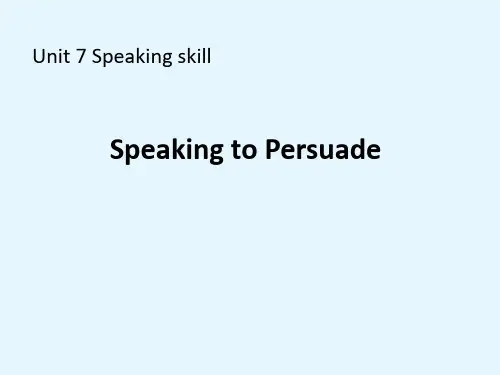
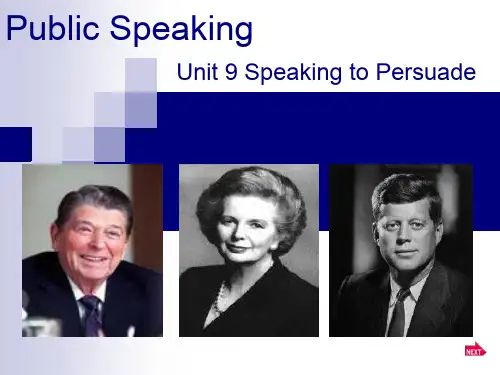
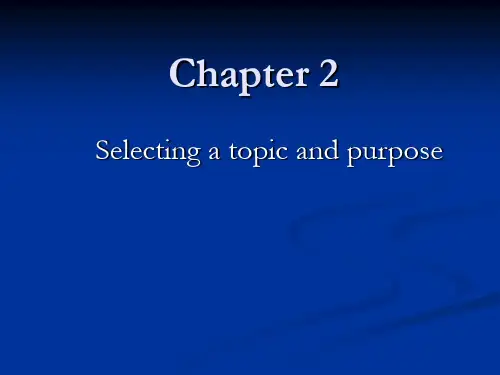
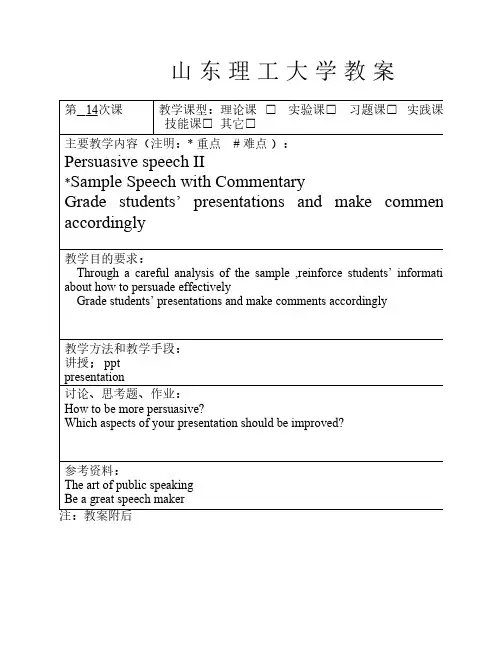
山东理工大学教案Lesson 12 Persuasive speeches IISample Speech with CommentaryThe following persuasive speech was presented in a public speaking class at the university of Wisconsin. It deals with a question of policy and is a good example of how students can utilize the methods of persuasion discussed in this chapter.Self-Defense on CampusRebecca HansonYou’re tired; you’re hungry. You’re just spent a long day at College Library and you can’t wait to gel back to your room. Glancing outside, you remember how quickly it becomes dark. You don’t think much of it, though, as you bundle up and head out into the gusty wind. Not until you spy the shadows on the sidewalk or hear the leaves rustling beside you do you wish you weren’t alone. You walk quickly, trying to stop your imagination from thinking of murderers and rapists. Only when you are safely inside your room do you relax and try to stop your heart from pounding out of your chest.The speaker begins with an extended hypothetical example. Vivid and richly textured, it gains attention and relates the topic directly to the audience .It also contains a strong element of emotional appeal—especially for female students who have experienced the feelings described by the speaker.Can you remember a time when you felt this way? I would be surprised if you never have. The FBI reported last year that there were three murders, approximately 430 aggravated assaults, 1,400 burglaries, and 80rapes here in Madison alone. And while these statistics are quite alarming, they don’t even compare to the numbers of larger metropolitan areas.When you begin a speech with a hypothetical example, it’s a good idea to follow up with statistics showing that the example is not farfetched. The statistics in this paragraph are especially effective because they come from the city in which the speech was given.No matter where we live, crime affects us all—men and women, students and instructors, young and old. We need to stop being the victims. One way we can do this is by enrolling in a self-defense course. There are many times I can remember when my heart seemed to pound out of my chest, but because I took an introductory course in self-defense, I feel more confident and more prepared to deal with potentially dangerous situations. Today I would like to encourage all of you to enroll in a self-defense course. Let’s start by looking at the dangers of crime we face as college students.After reinforcing the fact that crime is a concern for all members of her audience, the speaker focuses on the specific issue of enrolling in a self-defense course. She establishes her credibility by citing the benefits she gained from taking such a course. Although she stresses her personal experience here, it becomes clear as the speech goes on that she has also done a great deal of research on the topic.College students face many crime issues, both as members of society and as students on campus. These crimes endanger our money, our property, our self-confidence, our psychological well-being, and even our lives. According to the Foundation for Crime Prevention Education, violence and crime have dramatically increased. An American is six times more likely to be assaulted with a weapon today than in 1960. The FBI reports that someone is either murdered, raped, assaulted, of robbed every 16 seconds. This means today, at the end of our 50-minute class period, approximately 187 people will have been victims of a violent crime.This speech is organized according to Monroe’s motivated sequence. In this paragraph, the speaker begins her discussion of the need for students to enroll in self-defense course. Notice how she identifies the sources of her statistics and translates the figures into terms that relate directly to her classmates.College students, many of whom are away from home for the first time, are especially easy targets for crime. Students often look at campus housing as a secure place. But according to the book Street Wisdom for Women, precautions must be taken in a dorm or Greek house, just as in any house or apartment. How many of these bad habits do you have? How often do you leave your room without locking your door, forgetting how easily accessibleyour room is to anyone? How often do you fall asleep without locking your door? Or how often do you open your door without first checking to see who is there? As the Wake Forest University Police Crime Prevention website states,” Each of us must become aware of the precautions necessary to reduce the likelihood that we will become victims of crime.” Those who forget to take these precautions invite trouble.Moving from the general crime statistics in the previous paragraph, the speaker focuses on crime issues facing college students. Her questions about students’ “bad habits” with respect to crime prevention are especially effective, and her use of “you” helps draw the audience further into the speech. The quotation at the end of this paragraph is one of several pieces of evidence the speaker located on the Internet. Notice how she identifies the exact source of the quotation, rather than making the general statement “ As I discovered on the Web……”Although students must watch themselves in campus housing, they must also take care elsewhere. Prevalent use of drugs and alcohol, especially on college campuses, increases the chance of crime. Using drugs or alcohol makes you an easier target because, as we all know, it affects your judgment, influencing your decisions on safety. According to the Pacific Center for Violence Prevention, in 42 percent of all violent crimes, either the assailant, the victim, or both had been drinking. Specifically on campus, 90 percent of all violent crimes involve drugs and/or alcohol. This problem is so serious that testimony by law enforcement officials reprinted on the Security On Campus website indicates that many college campuses are the highest crime areas in their communities.The speaker completes the need section of her speech by noting that drugs and alcohol increase the crime problems faced by students. Here, as in other parts of the speech, her statistics are clearly presented and come from credible sources.So now that we see the dangers we face as students, what can we do to protect ourselves? Although there are many ways of dealing with crime, I recommend that you and every college student enroll in a self-defense course. You can choose from a variety of self-defense courses offered right here in Madison. You can find one to fit your schedule and your pocketbook. On campus, the university has a club sport called Shorin Ryu Karate, which emphasizes practical self-defense. They hold their meetings in the evening, after classes, right on campus, and they’re open to all university students,faculty and staff.This paragraph begins with a transition into the satisfaction section of the speech. Notice how clearly the speaker presents her plan and identifies the self-defense classes students can attend right on campus.Another option is Villari’s Self-Defense and Tai Chi Center, which not only offers courses in self-defense, but in tai chi, karate, and kung fu. Villari’s location on State Street is convenient for all university students. To find a class that fits your needs, you can also search over the Internet or through the Yellow Pages. I also brought along some brochures today, so if you are interested, please see me after class.Now the speaker looks at options for students who want to enroll in a self-defense class off campus. As in the previous paragraph, she provides specific information about those options. This kind of specificity is vital whenever a speaker seeks to persuade an audience to take immediate action.After enrolling in a self-defense course, you will find yourself much better prepared to deal with an emergency situation. Patrick Lee, an instructor for a course called “Self-Defense for Women: Victim or survivor,” claims the biggest thing he teaches in his courses is that you must decide from the beginning whether you want to be the victim or the survivor. Repeating over and over again that “I am a survivor” not only increases your self-confidence but helps you think more clearly in a difficult situation.Having explained her plan, the speaker moves into the visualization section of her speech, in which she will demonstrate the benefits of her plan. This is one of the most important aspects of any persuasive speech on a question of policy.I didn’t realize the importance of this myself until took an introductory course in self-defense in my high-school physical education class. After a few days of practice, each of us faced the notorious padded attacker. Expecting to enjoy fighting the attacker, I prepared to yell “NO; stop; back off,” as forcefully as possible. But before I knew it, this man, twice my size, had put me in a hold I could not get out of. My mind was so overcome with fear that I could barely muster out a “No.” immediately pictured this as a real situation, one which I probably would not have survived.In this and next paragraph, the speaker uses a personal example to illustrate the benefits of taking a self-defense class. The example also boosts the speaker’s credibility by showing that she has firsthand experience on the topic.But after a few more days of practice, we were able to go against the padded attacker one more time. This time, I no longer felt fear. I felt anger. I was angry that this man felt he could take advantage of me .This time, using what I learned, I yelled, “No; back off,” and successfully escaped his move. And this time I survived.The speaker’s success in repelling the padded attacker adds an element of emotional appeal to this section of the speech.I’m not the only example showing the benefits taking self-defense. If you’re interested, check out “Stories form Self-Defense Classes” posted to the internet by the Assault Prevention Information Network. Although I don’t have the time to share with you the dozens of success stories, I can sum them up with a quote by Cindy, 1 23-year-old woman who used her self-defense knowledge to scare off an assailant. Cindy says, “I know deep inside, where it matters most, that I have what it takes to defend myself if need be, and this feeling is one of pure joy.” As you can see ,self-defense is time and money well invested.As in other places, the speaker clearly identifies the source of evidence from the Internet. The quotation from Cindy is an instance of peer testimony, and it provides further proof of the benefits of taking a self-defense class. The final sentence of this paragraph reinforces the point made by the quotation and effectively wraps up the body of the speech.So I encourage you to enroll in a self-defense course, whether it be through a physical education class or through a private organization and whether you do it here or back in your home town. Even if you do not enroll right away, I encourage you to do so in the near future. Taking such a course could mean keeping your money, protecting your property, defending yourself, your boyfriend or girlfriend, husband or wife. It could even mean the difference between life and death.The speaker moves into her conclusion, in which she develops the action stage of Monroe’s motivated sequence. Notice how specific her call to action is and how she ties it directly to her classmates by talking in terms of “you”and “your”.Don’t ever think, “It could never happen to me .” Why not be prepared? As Patrick Lee said, “Ask yourself, do you want to be the victim or the survivor?”The closing quotation reinforces the speaker’s central idea, relates once again to the audience, and ends the speech on a dramatic note.。
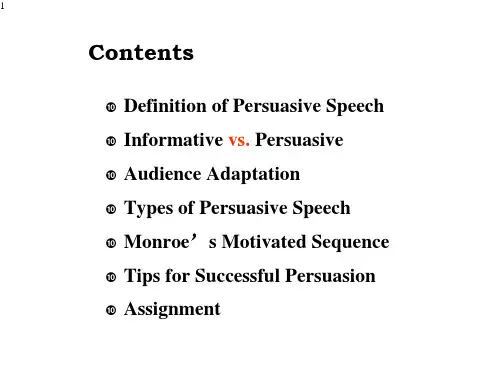

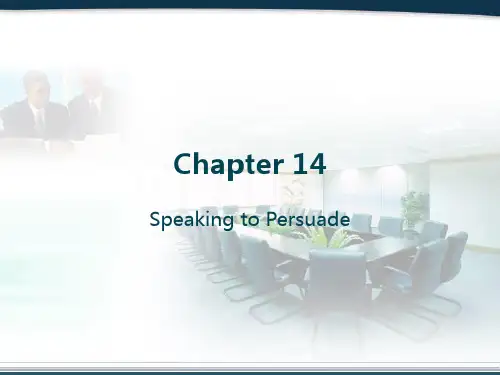
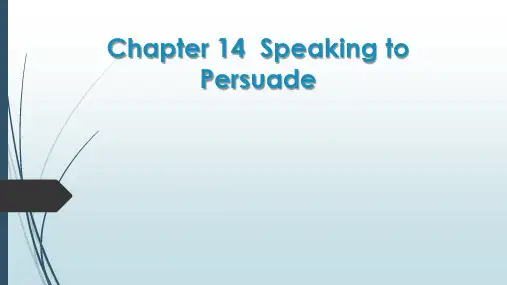
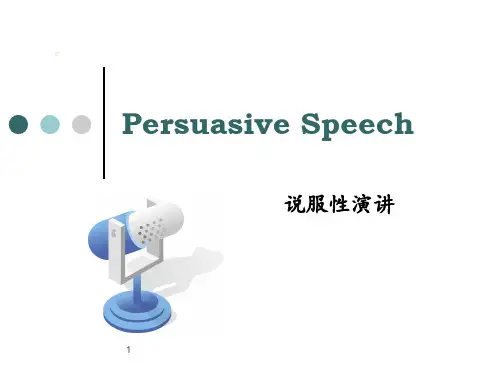
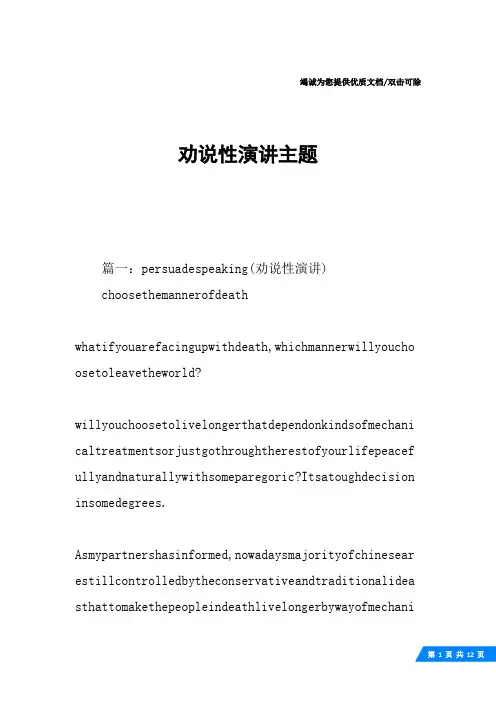
竭诚为您提供优质文档/双击可除劝说性演讲主题篇一:persuadespeaking(劝说性演讲)choosethemannerofdeathwhatifyouarefacingupwithdeath,whichmannerwillyoucho osetoleavetheworld?willyouchoosetolivelongerthatdependonkindsofmechani caltreatmentsorjustgothroughtherestofyourlifepeacef ullyandnaturallywithsomeparegoric?Itsatoughdecision insomedegrees.Asmypartnershasinformed,nowadaysmajorityofchinesear estillcontrolledbytheconservativeandtraditionalidea sthattomakethepeopleindeathlivelongerbywayofmechanicaltreatmentsisamanneroffilialduty.butwhatoutofthei rexpectationisthemuchmoreandmuchlongerpainthepeople willsuffer.comparedwithchina,Americanholdthedifferentpointofvi ewtowardsthisproblemaswehaveatotallydifferentconcep t.wearetoldanddeeplyaffectedbythetraditionalchinese thoughtscomefromconfuciusandotherancientcultures.on thecontrary,thoughwithashorterhistorythanchina,Amer icahasuniqueandrationalsocietyconceptsinmanyaspects.however,chineseandAmerican,onearth,havethecommontho ughtstowardsdeath.Andinsomedegree,Americanhasainfer iorunderstandingofdeaththanchineseowingtothehistory andculture.Yet,Americanhavechosentoavoidthemechanic altreatmentsandleavetheworldwithnopaintoinaccordwit htheirsense.however,tomaintainthelifeaslongaspossib lewithmechanicaltreatmentsiswhatmostchinesebelievei n.whatsmore,asweallknown,thetechnologyofAmericaismuch moreadvancedthanchinaandletalonethemedicine.withtheadvancedequipments,sometimesAmericanalsoshowhelples sandinabilitytothedeath.Theywilldotheirbesttosaveev erypatient,butforthepeopleindeath,theywouldratherch oosetogivetheparegorictolessenthepainandmakepatient spassedawaypeacefullyandpainlessly.Inthefaceofthedeath,thereisnodoubtthateveryonemaybe afraidofit.neverthelessitistherequiredcourseoflife. Thenwillyouwanttoleavetheworldwithtubesstillonyourb odyandsufferedpaintolivethemiserablelifewhenyouarei ndeath?howaboutwearapainlesssmilewhenweareatthedoor ofdeath.Asaoldsayinggoes:webornwithcryandtears,sowe shouldleavewithsmile.here,wepersuadeyoualltochoosethemannerofdeathwithmu chlittlepain,butwearenotdenytotryourbesttosavethepe oplewhoareabletobeingsaved.Forthepeoplewearenotcapa bleofsavingthem,thenwhatwecandoforthemistoreleaseth econstraintandhelptoreducethetimeofpaintheysuffered.篇二:劝说性演讲篇一:说服性演讲的五个步骤如何才能使自己的演讲与培训变成一次说服人的过程,而不是简单的信息传递呢?换句话说,如何才能使满肚子的蝴蝶飞出来,使传播更有效呢?要做到这一点,演讲者就必须做好以下两项基本工作:一是认真认真准备好讲稿,二是实施说服性演讲的五个步骤。
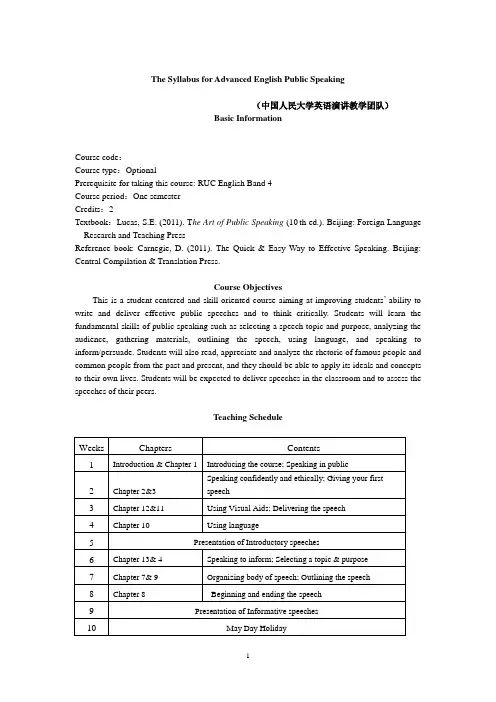
The Syllabus for Advanced English Public Speaking(中国人民大学英语演讲教学团队)Basic InformationCourse code:Course type:OptionalPrerequisite for taking this course: RUC English Band 4Course period:One semesterCredits:2Textbook:Lucas, S.E. (2011). T he Art of Public Speaking (10th ed.). Beijing: Foreign Language Research and Teaching PressReference book:Carnegie, D. (2011). The Quick & Easy Way to Effective Speaking. Beijing: Central Compilation & Translation Press.Course ObjectivesThis is a student-centered and skill-oriented course aiming at improving students’ ability to write and deliver effective public speeches and to think critically. Students will learn the fundamental skills of public speaking such as selecting a speech topic and purpose, analyzing the audience, gathering materials, outlining the speech, using language, and speaking to inform/persuade. Students will also read, appreciate and analyze the rhetoric of famous people and common people from the past and present, and they should be able to apply its ideals and concepts to their own lives. Students will be expected to deliver speeches in the classroom and to assess the speeches of their peers.Teaching ScheduleSpeech AssignmentsIntroductory speechFor this initial assignment, you are to construct a two-minute speech introducing yourself to the class. You may focus the speech on describing a significant experience, an educational moment from your life, an important personal belief, or a favorite hobby or interest. The purpose of the speech is not to persuade the audience to share the speaker’s views but to give the audience insight into speaker’s background, personality, attitudes, or aspirations. Even though you are not expected to memorize the speech, you should use as much eye contact as possible.Informative SpeechThe purpose of the informative speech is to create or facilitate understanding among your listeners. You may choose to speak on an object, concept, process or event. The target time for the speech is three minutes. As you practice, you should time your speech to ensure that it ends within 30 seconds of the target time. You are required to use at least one visual aid and at least three sources. At least one of these sources must be scholarly. You are allowed to use more than one source located through RUC licensed databases. Delivery of the speech is to be extemporaneous.Persuasive SpeechThe purpose of this speech is to persuade your audience for or against a question of policy, fact, or value. The target time for the speech is four minutes. You are required to use a minimum of four sources. At least one of these sources must be scholarly. Remember to cite your sources orally as you use them in your speech and to list them in your bibliography. You are required to highlight the sources in your outline.Impromptu SpeechFor this assignment, the teacher will assign you a topic. You will have ten minutes of preparation time and be expected to deliver a three-minute speech. The speech should include an introduction, a body and a conclusion.Academic IntegrityPlagiarism or other forms of cheating on exams and/or other class assignments will result in a failing grade on the assignment in question and may lead to failure in the course or other penalties. Cheating is violating the rules of the course. This includes copying others’ work, giving others your work to use as their own, using notes on an in-class test, looking at others’work when you are instructed to work alone, and breaking other rules, written or announced, that are part of class policy.Plagiarizing is representing written work as your own when you are not the original source. This includes failing to cite references, failin g to set others’ work in quotation marks, and paraphrasing insufficiently even if you do give credit to someone else. Thisalso applies to spoken work.Both oral and written assignments are due on the assigned dates. No late speeches. Late speeches will be at the discretion of the teacher. Grades on late written assignments will be deducted to a certain extent.Assessment and GradingPart I: Daily Performance (Attendance, quizzes, assignments) 30%Part II: Mid-term (Introductory Speech) 10%Part III: Final 60%(Informative Speech 15%; Persuasive Speech 25%; Impromptu Speech 10%;Self Assessment or Peer Assessment or Analysis of TED Speeches 10%)Teaching and Learning ResourcesSpeeches for Analysis in ClassStudent sample speechesPot, Soil, Water (University of Wisconsin)Confronting Myself: Color of the Wind By Xia PengThe Great Wall (University of Wisconsin)Yoga: Uniting Mind, Body, and Spirit (University of Wisconsin)Making a Difference Through the Special Olympics (University of Wisconsin)Question of Culture By Sajjid Zahir Chinoy (University of Richmond)A Scene to Remember By Gu Qiubei (Shanghai International Studies University)Famous SpeechesI Have a Dream By Martin Luther KingCommencement Speech at Standford University By Steve JobsCultural Programs and the 2008 Olympic Games By Yang LanChoices and Change By Barbaba BushYes, We Can By Barack ObamaSpeeches for Appreciation After Class1.I Have a Dream By Martin Luther King2.The Space Shuttle “Challenger” Tragedy Address By Ronal Reagan3.Choices and Change By Barbaba Bush4. A Whisper of AIDS By Mary Fisher5.Women’s Rights Are Human Rights By Hilary Clinton6.Noble Peace Prize Acceptance Speech By Wangari Maathai7.Tony Blair’s Third Term Speechmencement Speech at Stanford By Steve Jobs9.Eulogy for Rosa Parks By Oprah Winfrey10.The Fringe Benefits of Failure and the Importance of Imagination By J.K. Rowling11.2009 Shanghai Meeting with Future Chinese Leaders By Barack Obama12.The Queen’s Christmas Broadcast 201213.Gettysburg Address By Abraham Lincoln14.Blood, Toil, Tears and Sweat By Winston Churchill15.Inaugural Address By John F. KennedyPublic Speaking Websites/Reference textbooks1.Collins, P. (1998). Say It with Power & Confidence. Paramus: Prentice Hall.2.Carnegie, D. (2009). How to Develop Self-Confidence & Influence People by PublicSpeaking. Beijing: Central Compilation & Translation Press.3.Carnegie, D. (2011). The Quick & Easy Way to Effective Speaking. Beijing: CentralCompilation & Translation Press.4. Kay, S. (2005). Practical Presentations. Beijing: Foreign Language Teaching and ResearchPress.5. 《美国总统就职演说集》,郑启梅编译,武汉:武汉测绘科技大学出版社,1991。
劝说性英语演讲稿劝说性英语演讲稿篇一:说服性演讲演讲论题:同性恋婚姻Homosexual marriage should be bannedRecently I have read really a lot of articles and ments on hether homosexual marriage should be legalized or not. It gives me a headache. Let’s see hat ill happen if homosexual marriage is permitted by la.According to the international investigation, by 2016, the proportion of gay is around to to five percent of the hole population. And this ratio has been on the rise ever since, especially in the last fe years. We kno, many countries, such as the US, China, Russia, India and so on, are no confronted ith the problem of aging population caused by lo birth rates. Once it’s alloed to get married ith someone of the same sex, they don’t have their on kids, and th en the birth rates may even be loer. And hat’s more, once homosexual marriage is legalized, many potential gays ill join the rank ithout scruple. Then the situation ill be more serious than no. If this is the case, a series of social problems may be created folloing the aging-population problem, such as heaver social burdens, greater demand forexpenditure for social security and so forth…. Life ill be more difficult for our son.Some may say there ARE ays to solve the problem of children. By adopting, going to a sperm bank or borroing uterine, or doing hatever can be done ith science and technology. But not to mention moral problems or traditional conceptions, thetechnology is far from mature. And it increases the risk of variation. Even if they have a healthy baby ultimately, ill the kids turn out to be ell? Will the kids accept the fact that both his parents are men or omen? Will they feel it abnormal to gro up in a strange family and be able to endure the pressure of public opinion? Or ill they turn out to be homosexuals, either, because their groing environment tells them it is normal. The truth is it is not decent, not right, not normal. The present homosexual population is already plagued by the sick disease; ho can e risk our next generation?Some may also say true love should not be repressed. Everyone is entitled to true love regardless of gender. True love is not guilty: this may be the reason hy some people are in favor of homosexual marriage. But are you sure you really kno this kind of love? The American sexologist Junky said that many homosexuals resulted from the mental distortion. Homosexuality,more often than not, is a result of psychological problems, hich may havestemmed from the unfortunate experience in childhood, having been hurt in a heterosexual love, rongly pursuing the sexual pleasure or some other psychological problems. Legalization of homosexual marriage ill mean our tolerant attitude to a mental disease like depression. We ill be leaving this sickness to luck. Then it is inhumanity and brutality. Could e just stand by and atch it die its on course? Of course not.For all of these reasons, ho could e ignore the mental illness ofhomosexuals to legalize homosexual marriages? Ho could e disregard the happiness and health of our next generation to legalize homosexual marriages? Ho could e leave the developmentof our society to legalize homosexual marriages? As long as e have sense of responsibility, the anser should be definitely Not.篇二:persuade speech 劝说性英语演讲范文Stop the Rumor With WisdomDear classmates, I believe most of us have heared about at least 3 internet rumors. Such as: the orld ould end in 2016, the iodine in salt can protect people from nuclear radiation. In fact, e may have seen more rumors than e thought, that is because on the one hand, ith the help of internet, rumors are increasing sincemaking and spreading them is getting more and more convenient. On the other hand, some of them ere disguised ithauthority or science or even friendly reminder, hich make it more difficult to see through.In this situation, e must do something to stop internet rumor. Because it mislead people, fright peopleand damage the peaceof society, As apart of morden times internet munication, I highly remend us to do 3 things to prevent internet rumor.Firstly, e should never be the source of rumors. I kno most of us on’t make rumors on purpose, but e can’t ensure hat e said on’t be used by other individuals intentionally, or our original meaningson’t be misinterpreted.Although th e internet is open and free, that doesn’t mean e can say hatever e ant ithout a second thought.Secondly, e shouldn’t help the spread of internet rumors. Because the ilder the rumor spreaded, the more damage it ill cause. We all kno thatthree people spreading reports of a tiger make you believe there is one around. Thanks to the internet, no e can spread the rumor ith only one share button. Even though e didn’t take the rumor for real hen e push the button, it is possible for others to believe these rumors because they trustus. In the orst situation, our reputation may be destoried by this reckless behavior.Last but not least, e should try our best to terminate the rumor. And that depends on our isdom.In most cases, the rumors alays pretend to be the truth, for that most of us ould rather believe than not. But in fact, that doesn’t benefit anyone. The right ay is keepingsuspicious about hat e seeand hear, especially ofthose shocking or illogical. And using our professnial knoledge to make the right choice.As the old saying goes, the ise men ended rumours. I believe as graduate students, e have enough isdom to be the terminators of rumor. So, let’s stop the rumor ith isdom.篇三:介绍性英语演讲稿 Morning everyone,Ifeel excited to have the chance to give you a short speach here. Let’s see a phenomenon,e can’t live for a minite ithout it,cellphone.Just as a fish can’t live ithout ater.But hy is cell phone so attractive?Iguess that it is softare applications that makes it. nWhether you acknoledge or not,smart phone has changed our lives in the past ten years.Sincerely speaking,softaer applications make our lives more and more colorful.They cover almost every aspects of our lives,such asclothing,eating,travelling,payingand entertaining.These kinds of softare applications makes us approach to everything.We can order take out even in dormotory.They give us a moving map hen e are travelling.What’s more.,they provide us ith quantities of games,hich occupys almost all our free time.Ten years have seen the rapid development of softare applications.It’s really unbelieveable that they developed so prehensively,they have became helpers of us.They beepractical,they press close to the tendency.In addition,they make our lives more and more convenient.It’s a tendency tha t everything is to develop into mobile one,hich truly makes room for softare applications.People rae accustomed to paying on phone.And other people have the desire to do everything by their smart phone.since the softare applications are used so frequently,safty and pravicy truly catch our attention.So hat’s the tendency of requirement of market today?Or hat’s the development of softare applications in the future?Maybe the inventors are supposed to focus on the tendency of the development of the orld,pay attention to the requirement of users.What’s more,hat’s the most important is safty. Only follo the tendency can they develop ell.That’s all my speech.Thank you for listening.1篇四:终身学习的必要性演讲打分细则:1-5分1、演讲者要和听众目光接触,除非确有必要再看书面提示;2、声音足够大保证每位听众能够听到;3、使用适当的语速;4、演讲要有趣、吸引人,富有知识性。
山东理工大学教案注:教案附后Lesson 11 Persuasive speech I---Speaking to persuadePersuasion is the process of creating, reinforcing, or changing people’s beliefs or actions. When you speak to persuade, you act as an advocate. Your job is to sell a program, to defend an idea, to refute an opponent, or to inspire people to action. The ability to speak persuasively will benefit you in every part of your life, from personal relations to community activities to career aspirations.I. The psychology of persuasionAs with other kinds of public speaking, you will be most effective in persuasion if you approach it systematically. The first step is to understand that persuasion is a psychological process. It occurs in a situation where two or more points of view exist. The speaker supports school vouchers, but many listeners do not. The speaker considers doctor-assisted suicide immoral, but some in the audience think it is justified in certain circumstances, The speaker wants everyone in the audience to sign up immediately to learn CPR, but most listeners are inclined to procrastinate and will do it "someday." The different points of view may be completely opposed, or they may simply be different in degree. Whichever the case, there must be a disagreement, or else there would be no need for persuasion.II. The challenge of Persuasive SpeakingOf all the kinds of public speaking, persuasion is the most complex and the most challenging. Your objective is more ambitious than in speaking to inform, and audience analysis and adaptation become much more demanding. In some persuasive speeches you will deal with controversial topics that touch on your listeners' most basic attitudes, values, and beliefs, This will increase your listeners' resistance to persuasion and made your task much more difficult. What seems perfectly logical to some listeners may seem wildly irrational to others. No matter how expert you are on the topic, no matter how skillfully you prepare the speech, no matter how captivating your delivery-some listeners will not agree with you.This does not mean persuasion is impossible. It does mean you should enter a persuasive speaking situation with a realistic sense of what you can accomplish. You can't expect a group of die-hard Democrats to become Republicans or a steak lover to turn vegetarian as a result of one speech.In every persuasive speech, you will face some listeners who are strongly in favor of your position, some who are neutral, and some who are adamantly opposed.. If listeners are neutral or only moderately committed one way or another, you can realistically hope your speech will move at least some of them toward your side. If listeners are strongly opposed to your viewpoint, you can consider your speech a success if it leads even a few to reexamine their views.How successful you are in any particular persuasive speech will depend above all on how well you tailor your message to the values, attitudes, and beliefs of your audience. Persuasion is a strategic activity. Just as a businesswoman or a military commander plots a strategy to gain a big sale or to be victorious in battle, so a persuasive speaker must have a strategy to win the audience to her or his side.In order to hit your target, some methods must be used. Next, we will focus on the three major kinds of persuasive speeches and how to organize them most effectively. We will first look at speeches on questions of fact, then at speeches on questions of value, and finally at speeches on questions of policy.III. Persuasive speeches on questions of factWhat are questions of fact? ---A question about the truth or falsity of an assertion.Many questions of fact cannot be answered absolutely,. There is a true answer, but we do not know enoughinformation to know what it is. Some questions like this involve prediction: will the economy be better or worse next year? Will another earthquake strike California before the year 2010?Other questions deal with issues on which the facts are murky or inclusive. What will happen next in the Middle East? Is sexual orientation genetically determined? Did Shakespeare really write the plays attributed to him? No one knows the final answers to these questions, but that doesn’t stop people from thinking about them or from trying to convince other people that they have the best possible answers.This kind of speeches is usually organized topically. Suppose you are trying to persuade your audience that genetically engineered crops pose serious dangers to the environment and to human health. Your specific purpose, central idea, and main points might be:Specific purpose: To persuade my audience that genetically engineered crops pose serious dangers to the environment and to human healthCentral idea: Genetically engineered crops have the potential to create major environmental and health hazards. Main points:I.. Genetically engineered crops will create environmental havoc by harming beneficial insects while creating superbugs and superweeds that will be very difficult to control.II. Genetically engineered crops will create health problems by introducing harmful toxins and allergens into foods without the knowledge of consumers.IV. Persuasive speeches on questions of valueWhat are questions of value? ---A question about the worth, rightness, morality, and so forth of an idea or action.What is the best movie of all time?Is the cloning of human beings morally justifiable? What are the ethical responsibilities of journalists? Such questions not only involve matters of fact, but they also demand value judgments---judgments based on a person’s beliefs about what is right or wrong, good or bad, moral or immoral, proper or improper, fair or unfair.Take the issue of cloning. It can be discussed at a purely factual level by asking, ―What are the scientific methods of cloning?‖ or ―What are the differences between cloning and genetic engineering?‖ These are questions of fact. It has nothing to do with the morality of cloning.But suppose you ask, ―Is it morally justifiable to clone human being?‖ or ―Is it ethically acceptable to clone human cells in an effort to cure diseases such as AIDS and cancer?‖ Now you are dealing with questions of value. How you answer will depend not only on your factual knowledge about cloning, but also on your moral values.Persuasive speeches on questions of value are mostly organized topically. The most common approach is to devote your first main point to establishing the standards for your value judgment and your second main point to applying those standards to the subject of your speech.Specific purpose: To persuade my audience that bicycle riding is the ideal form of land transportation.Central idea: bicycle riding is the ideal form of land transportation because it is faster than walking or running, does not exploit animals or people, is nonpolluting, and promotes the health of the rider.Main points:I. An ideal form of land transportation .should meet four major standardsA.It should be faster than walking or running.B.It should not exploit animals or people.C.It should be nonpolluting.D.It should be beneficial for the person who uses it.II. Bicycle riding meets all these standards for an ideal form of land transportation.A. Bicycle riding is faster than walking or running.B. Bicycle riding does not exploit the labor of animals or of other people.C. Bicycle riding is not a source of air, land, water, or noise pollution.D. Bicycle riding is extremely beneficial for the health of the rider.V. Persuasive speeches on questions of policy1. What are questions of policy? ---A question about whether a specific course of action should or should not be taken.Questions of policy arise daily in almost everything we do. At homes we debate what to do during spring vacation, whether to buy a bigger TV, which movie to see on the weekend. At work we discuss whether to go on strike, what strategy to use in selling a product, how to improve communication between management and employees. As citizens we ponder what to do about airport security, how to maintain economic growth and protect the environment.All theses are Questions of policy because they deal with specific courses of action. Questions of policy inevitably involve questions of fact. (How can we decide whether to vote for a candidate unless we know the facts of his or her stand on the issue?) They may also involve questions of value. (The policy you favor on abortion will be affected by whether you think abortion is moral or immoral.) But questions of policy always go beyond questions of fact or questions of value to decide whether something should or should not be done.Questions of policy usually include the word ―should‖, as in these examples:What measures should be taken to protect the United States against terrorist attacks?Should same-sex marriages be legalized?What steps should be taken to ensure that all the people in China receive adequate health care?2. Organizing speeches on Questions of policyFour basic patterns are especially useful for policy speeches. They are:A. Problem-solution order:A method of organizing persuasive speeches in which the first main point deals with the existence of the problem and the second main point presents a solution to the problem.B. Problem-cause-solution orderA method of organizing persuasive speeches in which the first main point identifies a problem, analyzes the cause of the problem, and the third main point presents a solution to the problem.C. Comparative Advantage orderA method of organizing persuasive speeches in which each point explains why a speaker’s solution to a problem is preferable to other proposed solutions.Specific purpose: To persuade my audience that the U.S. space program should put greater priority on unstaffed scientific missions that gather information about the planets and the solar system.Central idea:unstaffed scientific missions are less costly and more beneficial than staffed space flight.Main points:I. unstaffed scientific missions are less costly than staffed space flight.II. unstaffed scientific missions provide more practical benefits than staffed space flight.D. Monroe’s motivated sequenceA method of organizing persuasive speeches that seek immediate action. The five steps of the motivated sequence are attention, need, satisfaction, visualization, and action. I t was developed in the 1930s by Alan Monroe,a professor of speech at Purdue University. The sequence has five steps that follow the psychology of persuasion:1. Attention. First you gain the attention of your audience. You do this in the introduction by using one or more the methods described before: relating to the audience, showing the importance of the topic, making a startling statement, arousing curiosity or suspense, posing a question, telling a dramatic story, or using visual aids.2. Need. Having captured the interest of your audience, you next make them feel a need for change. You show there is a serious problem with the existing situation. It is important to state the need clearly and to illustrate it with strong supporting materials---statistics, examples, and testimony—that relate directly to the audienc e’s values or vital interests. By the end of this step they are psychologically primed to hear your solution.3. Satisfaction. Having aroused a sense of need, you satisfy it by providing a solution to the problem. You present your plan and show how it will work. Be sure to offer enough details about the plan to give listeners a clear understanding of it.4. Visualization. Having given your plan, you intensify desire for it by visualizing its benefits. They key to this step is using vivid imagery to show your listeners how they will profit from your policy. Make them see how much better conditions will be once your plan is adopted.5. Action. Once the audience is convinced your policy is beneficial, you are ready to call for action. Say exactly what you want the audience to do---and how to do it. Then conclude with a final stirring appeal that reinforces their commitment to act. A lot of commercial follow this guide, next you watch TV, keep an eye for it.Specific purpose: To persuade my audience to help children worldwide by contributing to Compassion InternationalCentral idea:Contributing to an organization such as Compassion International can help break the cycle of poverty that affects millions of children.IntroductionAttention: I. For every morning that you wake up an eat breakfast, millions of children begin their daily struggle with chronic hunger and poverty.II. By sponsoring a child for two years through an organization called Compassion International, I have seen the difference it can make in a child’s life.III. Today, I would like to encourage all of you to become involved with Compassion International BodyNeed. I. Millions of children in developing countries suffer from poverty, hunger, and lack of education.A. Poverty destroys the quality of life for children in developing countries from Asia to South America.B. Hunger takes the lives of almost 20,000 children under the age of five each year.C. Lack of education helps perpetuate the vicious cycle of hunger and poverty.Satisfaction: II. Groups such as Compassion International can help break this cycle.A.Founded in 1952, Compassion International provides food, clothing, education, shelter, and health care forchildren in 22 countries across the globe.B.You can sponsor a child for just $28 a month.C.For two years I have been sponsoring a little boy in Ecuador named Jose Francisco.Visualization: III. Compassion International has an impressive record as a truly effective charity.A.According to the Better Business Bureau, 78 percent of donated funds go directly to the children.B.Internal and external audits ensure that all funds are properly received, tracked, and managed for each child.C.Smart Money magazine ranks Compassion International as one of the top 10 charities in the United States.ConclusionAction: I. So I encourage each of you to sponsor a child through Compassion International.II. As Compassion International states, ―while we cannot individually change the world, we canchange the world for one child.‖Try using the motivated sequence when you seek immediate action from your listeners. Over the years it has been worked for countless speakers---and it can work for you as well.SummaryYou should think of your speech as a kind mental dialogue with your audience.Persuasive speeches may center on questions of fact, questions of value, questions of policy. Some of the questions of fact can be answered absolutely, others cannot---either because of the facts are murky or because there is not enough information available to us. When giving a persuasive speech about a question of fact, your role is akin to that of a lawyer in a courtroom trial. You will try to get your listeners to accept your view of the facts.Questions of value go beyond the facts to involve a person’s beliefs about what is right or wrong, good or bad, moral or immoral. When speaking about a question of value, you must justify your opinion by establishing standards for your value judgment. Although questions of value often have strong implications for our actions, speeches on questions of value do not argue directly for or against particular courses of action.Once you go beyond arguing right or wrong to urging that something should or should not be done. You move to a question of policy. When you speak on a question of policy, you goal may be to evoke agreement or immediate action.There are several options for organizing speeches on questions of policy. If you advocate a change in policy, you main points will often fall naturally into problem-solution order or into problem-cause-solution order. If your audience already agrees that a problem exists, you may be able to use comparative advantages order. When you seek immediate action from listeners, you should consider a more specialized organizational pattern known as Monroe’s motivated sequence, whose five steps are based on the psychology of persuasion.Methods of persuasionWhat makes a speaker persuasive? Why do listeners accept one speaker’s views and reject those of another speaker? How can a speaker motivate listeners to act? People have been trying to answer questions for thousands of years—from the Ancient Greek philosopher Aristotle to modern –day communication researchers.Listeners will be persuaded by a speaker from one or more of four reasons:Because they perceive the speaker as having high credibility.Because they are won over by the speaker’s evidence.Because they are convinced by the speaker’s reasoning.Because their emotions are touched by the speaker’s ideas or languagesI. Building credibilityFactors of credibility: A speaker’s credibility is affected by two factorsCompetence---how an audience regards a speaker’s intelligence, expertise, and knowledge of the subject. Character---how an audience regards a speaker’s sincerity, trustworthiness, and concern for the well-being of the audience.The more favorably listeners view a speaker’s competence and character, the more likely they are to accept what the speaker says.It is important to remember that credibility is an attitude. It exists not in the speaker, but in the credibility mind of the audience. A speaker may have high credibility for one audience and low credibility for another. A speaker may also have high credibility on one topic, and low credibility on another.Enhancing your credibility1. Explain your competenceOne way to enhance your credibility is to advertise your expertise on the speech topic. If you investigated the topic thoroughly, say so. If you have experience that gives you special knowledge or insight, say so.The example stressed the speaker’s study and research:I never knew much about UFOs until I did a research on them in my high school science class. Since then, I have read quite a bit about them, including the latest reports of the highly respected Center for UFO Studies in Evanston, Illinois. As a result, I have decided that the evidence strongly suggests that Earth has been---and continue to be---visited by spaceships from other planets.2. Establishing common ground with your audienceCreating common ground---a technique in which a speaker connects himself or herself with the values, attitudes, or experiences of the audience.You do not persuade listeners by assaulting their values and rejecting their viewpoints. It makes the audience resist your ideas. Instead, You should show respect for your listeners, you identify your ideas with those of your audience.Creating common ground is especially important at the start of a persuasive speech. Begin by identifying with your listeners. Show that you share their values, attitudes, and the experiences. Getting them nodding their heads in agreement and they will be much more receptive to your proposal.Here is how a businesswoman from Massachusetts, hoping to sell her product to an audience of proper in Colorado, began her persuasive speech:I have never been in Colorado before, but I really looked forward to making this trip. A lot of my ancestors left Massachusetts and came to Colorado nearly 150 years ago. Sometimes I have wondered why they did it. They came in covered wagons, carrying all their possessions, and many of them died on the journey. The ones who got through raised their houses and raised their families. Now that I have seen Colorado, I understand why they tried so hard! The audience laughed and applauded, and the speaker was off to a good start.3. Deliver your speeches fluently, expressively, and with convictionA lot of research show that a speaker’s credibility is strongly affected by his or her delivery. Moderately fast speakers are usually seen as intelligent and confident than slower speakers. So are speakers who use vocal variety to communicate their ideas in a lively way.II. Using evidenceEvidence consists of supporting material---examples, statistics, testimony—used to prove or disapprove something. If you hope to be persuasive, you must support your views with evidence. Whenever you say something that is open to question, you should give evidence to prove you are right.Tips for using evidenceAny of the supporting materials discussed in Chapter 9-- examples, statistics, and testimony---can work as evidence in a persuasive speech. And in Chapter 9, many guidelines were given. Here we need to look at four special tips for using evidence in a persuasive speech.1. Use specific evidence. No matter what kind of evidence you employ, it will be more persuasive if you state it in specific rather than general terms. In the speech about noise pollution, for instance, the speaker did not say, ―Lots of people suffer from hearing loss.‖That would have left the audience wondering how many ―lots‖amounts to. By saying ―28 million Americans suffer from serious hearing loss,‖ the speaker made her point much more effectively. She also enhanced her credibility by showing she had a firm grasp of the facts.2. Use novel evidence. Evidence is likely to be persuasive if it is new to the audience. Do not use facts and figures that are already well-known to your listeners.3. Use evidence from credible sources. Research shows that listeners find evidence from competent, credible sources more persuasive than evidence from less qualified sources. If you wish to be persuasive, you should rely on evidencefrom objective, nonpartisan sources.4. Make clear the point of your evidence. When speaking to persuade, you use evidence to prove a point, so when using evidence, be sure listeners understand the point you are trying to make.III. ReasoningReasoning---the process of drawing a conclusion on the basis of evidence.As a public speaker you have two major concerns with respect to reasoning. First, you must make sure your own reasoning is sound. Second, you must try to get listeners to agree with your reasoning. Lets look at four basic methods of reasoning and how to use them in speeches.1. Reasoning from specific instances--- reasoning that moves from particular facts to a general conclusion. For example:Fact1: My physical education course last term was easy.Fact 2: My roommate’s education course was easy.Fact 3: My brother’s education course was easy.Conclusion: Physical education courses are easy.We reason from specific daily though we probably don’t realize it: for instance: Politicians are corrupt, professors are bookish. School food is awful.When you reason from specific instances, you should follow a few basic guidelines:A. Avoid generalizing too hastily, make sure your sample of specific instances is large enough to justify your conclusion.B.Be careful with your wording. If your evidence does not justify a conclusion, qualify your argument.C.Reinforce your argument with statistics and testimony2. Reasoning from principle---reasoning that moves from a general principle to a specific conclusion. For instance:1.All people are mortal.2.Socrates is a person.3.Therefore, Socrates is mortal.Another example:1.The United States Constitution guarantees all U.S. citizens the right to vote.2.Women are U.S. citizens.3.Therefore, the United States Constitution guarantees women the right to vote.3. Causal reasoning---reasoning that seeks to establish the relationship between causes and effects.There is a patch of ice on the sidewalk. You slip, fall, and break your arm. You reason as follows: ―Because that patch of ice was there, I fell and broke my arm.‖ or―If the patch of ice hadn’t been there, I wouldn’t have fallen and broken my arm.‖4. Analogical reasoning---reasoning in which a speaker compares two similar cases and infers that what is true for the first case is also true for the second.If you are good at racquetball, you’ll be great at Ping-Pang.In Great Britain the general election campaign fro Prime Minister lasts less than three weeks. Surely we can do the same with the U.S presidential election.Both statements are reasoning from analogy. By comparing two similar cases, they infer that what is true for one must be true for the other.The most important thing in analogical reasoning is whether the two cases being compared are essentially alike. If they are essentially alike, the analogy is valid, if not, the analogy is invalid.Here is how one student used reasoning from analogy to support her claim that controlling handguns will reduce violent crime in the United States.Will my policy work? The experience of foreign countries suggests it will. In England, guns are strictly regulated; even the police are unarmed, and the murder rate is trivial by American standards. In Japan, the ownership of weapons is severely restricted, and handguns are completely prohibited. Japan is an almost gun-free country, and its crime rate is even lower than England’s. On the basis of theses comparisons, we can conclude that restricting the ownership of guns will control the crime and murder rates in America.IV. Appealing to emotionsEffective persuasion often requires emotional appeal. And then what are emotional appeals?---emotional appeals are intended to make listeners feel sad, angry, guilty, afraid, happy, proud, sympathetic, reverent, or the like. Theses are often appropriate reactions when the question is one of value or policy.Below is a list of some of the emotions evoked most often by public speakers. Following each emotion are a few examples of subjects that might stir that emotion:Fear---of serious illness, of natural disasters, of sexual assault, of personal rejection, of economic hardship. Compassio n---for the physically disabled, for battered women, for neglected animals, for the unemployed, for starving children, for victims of AIDS.Pride---in one’s country, in one’s family, in one’s school, in one’s ethnic heritage, in one’s personal accomplishments.Anger--- at terrorists and their supporters, at business leaders who act unethically, at members of Congress who abuse the public trust, at landlords who exploit student tenants, at vandals and thieves.Guilt—about not helping people less fortunate than ourselves, about not considering the rights of others, about not doing one’s best.Reverence---for an admired person, for traditions and institutions, for one’s deity.Of course, there are many other emotions and many other subjects that might stir them.Guidelines for generating emotional appeal1. Use emotional languageUse emotion-laden words, moving language. Let’s see a conclusion part of a student speech about the challenge and rewards of working as a community volunteer with young children.The promise of America sparkles in the eyes of every child. Their dreams are the glittering dreams of America. When those dreams are dashed, when innocent hopes are betrayed, so are the dreams and hopes of the entire nation. It is our duty---to me, it is a sacred duty---to give all children the chance to learn and grow, to share equally in the American dream of freedom, justice, and opportunity.2. Develop vivid exampleThe most effective way to generate emotions is with vivid, rich textured examples that personalize your ideas and help pull listeners into the speech emotionally.3. Speak with sincerity and convictionKeep this in mind: all your emotion-laden words and examples are but empty trapping unless you feel the emotion yourself. And if you do, your emotion will communicate itself to the audience through everything you say and do---not only through your words, but also through your tone of voice, rate of speech, gestures and facial expressions.SummaryPeople have been studying the methods of persuasion since the days of the ancient Greek. They have found that。